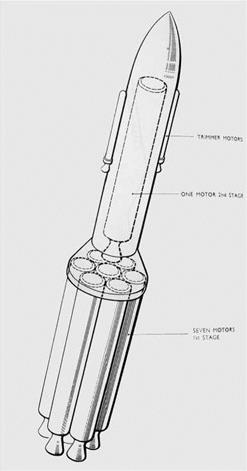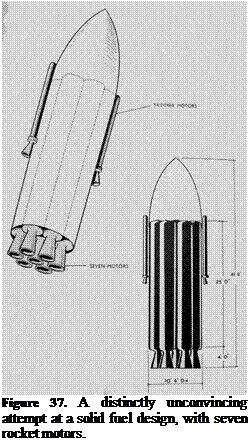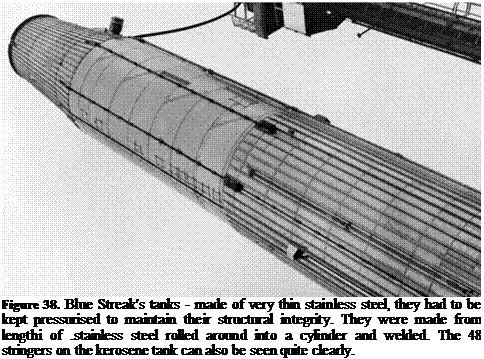A Solid Fuel Design?
A report from Westcott dated December 1956 considered the ‘Application of Solid Propellant Motors to Medium Range Ballistic Missiles’8. Its summary states that
The studies are based chiefly on the studies of motors with plastic propellant charges of maximum length 25 ft and maximum diameter 3 ft 6 in. These maximum dimensions are considered feasible with radial burning plastic propellant charges… and are within the pressing limits of facilities already planned and requested… For a missile carrying a 4,000lb warhead, fitted with clustered motor units, the ranges calculated for single stage and two stage propulsion are respectively up to 1,300 miles and up to 2,500 miles.
Not surprisingly, given the lack of experience with solid fuel motors of such size, the report is somewhat lacking in precise detail, but instead takes various arrangements of mo tors and makes an estimate (or guess) at the range obtainable from each one.
The individual motors shown in the sketches are also very generic: other than being 3 ft 6 inches diameter and 29 ft 2 inches long, there is very little information about them. Quite why these particular dimensions have been chosen is not obvious.
 It is clear that the option of using solid fuel motors was not taken very seriously – there is no mention of them at all in policy papers, and it is quite possible that the study was undertaken so as to be seen to have covered all possibilities. It does not appear from the report that there had been wide consultation with those who were actually producing solid fuel motors – the limits imposed on the dimensions seem to have been rather arbitrary. Certainly there is no discussion of the degree of practicality of building motors as large as these or larger.
It is clear that the option of using solid fuel motors was not taken very seriously – there is no mention of them at all in policy papers, and it is quite possible that the study was undertaken so as to be seen to have covered all possibilities. It does not appear from the report that there had been wide consultation with those who were actually producing solid fuel motors – the limits imposed on the dimensions seem to have been rather arbitrary. Certainly there is no discussion of the degree of practicality of building motors as large as these or larger.
The payload used in the calculations is given as 4,000 lb –
Figure 36. Proposed solid fuel missile. given the later reduction in the
weight of the payload it might have
been worth revisiting some of these ideas. Unfortunately the idea of a liquid fuel missile had become too firmly entrenched by then – which is, in many ways, a pity. For comparison, let us look at the American solid fuel Minuteman missile.
The US Air Force began looking at the possibility of solid fuel motors in August 1957, in response to the Navy’s Polaris missile. The task was given to Colonel Edward Hall, who calculated that ‘the ICBM version of Weapon System Q [i. e., Minuteman] would be a three-stage, solid-fuel missile approximately 65 feet long, weighing approximately 65,000 pounds, and developing approximately 100,000-120,000 pounds of thrust at launch’. The missile would be stored vertically in underground silos and ‘would accelerate so quickly that it could fly
through its exhaust flames and not be significantly damaged’. The system was approved in February 1958 and the first successful launch was in February 1961, when the re-entry vehicle travelled a distance of 4,600 miles. Its design range was 5,500 miles. The first stage was 65 inches in diameter and 22 ft high; the whole missile was 55 ft tall – in other words, shorter than Blue Streak, almost half the diameter, a third of the weight, and it could deliver its payload near three times as far! The warhead yield was 1.2 MT and the re-entry vehicle plus warhead would have weighed in the or der of 1,000 lb.
 Even though the US was considerably ahead in the design of solid fuel motors, developing a British solid-fuelled missile would have been quite feasible, and probably no more expensive or time consuming than developing Blue Streak, but the idea was taken no further.
Even though the US was considerably ahead in the design of solid fuel motors, developing a British solid-fuelled missile would have been quite feasible, and probably no more expensive or time consuming than developing Blue Streak, but the idea was taken no further.
The outlines of the design were now beginning to emerge: liquid fuelled, two motors, all up weight approaching 200,000 lb. It took some time for a more detailed design to emerge, however. Thus Joe Lyons of the RAE wrote in February 1956:
It had been agreed in principle that it would be a thin steel missile with propulsion at rear and the warhead at front. Titanium had been considered for the skin but was not promising. A cylindrical structure of about 10 ft diameter and length of about 60-70 ft was generally agreed. It was probable that fins would be fitted but this was not completely certain yet.9
Even the use of the NAA motors was still to be debated. A note from Serby, DG/GW (Director General/Guided Weapons at the Ministry of Supply) in March 1956 reads:
Should the missile be designed as a single-stage weapon using 2 x 135,0001b NAA motors since the AUW (All Up Weight) could be reduced and the requirement for thrust control could be eliminated if a number of smaller motors could be used?10
The thrust control issue arose from the use of large rocket motors: towards the end of the flight, when almost all the fuel was consumed, accelerations became unacceptably high. Thus there was a proposal to throttle back the motors: not an easy task.
The firms detailed to do the work had been decided back in 1955.
It is proposed that Messrs de Havilland should be responsible for the airframe and general weapon co-ordination, Rolls Royce for the rocket motor and fuel system design, Sperry for the internal inertial ‘guidance’ and autopilot, Marconi for the ground radar launching system.
Whilst relationships between the firms and the Ministry were usually good, this was not always the case with de Havilland, particularly in the early days. There were considerable cost overruns at a time of financial stringency, and at one stage the Ministry went as far as sending in Cooper Brothers, a firm of accountants from the City, to check the costs and management. And with reference to talks with Rolls Royce in 1958, the Ministry noted that
they share the view with everybody else that de Havilland can be extremely difficult and very unsatisfactory, but have no complaints to make over their immediate contacts in this particular connection. Indeed, at the working technical levels, they have a very high opinion of the de Havilland staff, but, here again, they fully share the general view about de Havilland top level people.11
To be fair, we are not given de Havilland’s views on Rolls Royce!
The debate as to the missile structure had been effectively settled by April 1957, when Wing Commander Bonser of the Ministry of Supply noted that:
A list of equipment required for the building of the ‘Blue Streak’ airframe has been submitted by the De Havilland Aircraft Division…
The equipment is required to reproduce that used by Convair for the production of the same type of pressurised structure for an American Ballistic missile. This type of structure is unique to Ballistic missiles and consists of a series of rings in stainless steel and seam welded. These rings are then welded together and fitted with stainless steel domes to form the main tanks for the liquid oxygen and kerosene. The resulting structure is of such strength that it must be kept under pressure in order to retain shape.
This very light structure and the method of production has been developed by Convairs over a very long period (5-10 years) and to save time is to be copied by De Havilland. So important is this feature of the ‘Blue Streak’ programme that it has been decided that the British missile shall have the same diameter as the American one. This means that the tools, jigs and fixtures can be reproduced with the minimum loss of time – a most important feature as the first structure is required by mid-1957.
It might be thought that work could now go ahead on Blue Streak without any further problems, but with Blue Streak that was never the case. There was constant opposition to the project throughout its life within Whitehall. This surfaces most clearly in the Treasury, but other ministries such as the Admiralty, were also against the project, as we shall see. Indeed, even the Permanent Secretary at the Ministry of Supply, the Ministry whose job it was to develop Blue Streak, was against the project. Sir Roger Makins of the Treasury, one of the ‘Great and the Good’ of the 1950s and 1960s, reported a conversation thus:
Sir Cyril Musgrave, of the Ministry of Supply, came to see me on 14th November [1956], to talk about the Medium Range Ballistic Missile. His primary objective was to talk about Spadeadam, and when I told him the Chancellor had made a decision, the main point of his visit was lost. However, he did say that the Ministry of Supply was having great difficulty in holding De Havillands at arm’s length, particularly now that the American Government had approved the contract with Convair.
I explained that the Chancellor had felt it desirable to hold up his approval of this transaction until he had an opportunity of considering the future of the M. R.B. M. in relation to the rest of the air weapons programme. On this, I believed that the Ministry of Defence were on the point of producing a paper. I would certainly do what I could to accelerate both its appearance and consideration. Sir Cyril Musgrave turned out to be a bitter opponent of the M. R.B. M. and a passionate advocate of the supersonic bomber [the Avro 730, cancelled in 1957]. He evidently relished locking horns with the Ministry of Defence on this subject.12
The transaction being referred to was the licencing by de Havilland of the technique for building the tanks – the decision had been taken to use the same construction method as the Atlas missile, with its ‘balloon’ stainless steel tanks. The passage about Musgrave is, on the face of it, extraordinary – the Ministry of Supply was simply a procurement ministry, and was not supposed to decide military policy. It demonstrates how blurred the lines can become at times.
The Chancellor certainly did hold up his approval. That conversation was in November 1956, the proposal had been made and put to the Americans; the Americans had agreed, but still the Treasury held out. The proposal reached the Chancellor himself (‘Rab’ Butler) on 4 July 1957 – eight months later. The memo began:
This is a proposal that de Havillands should buy from the American Company Convair some ‘knowhow’ for the development and production of a British intermediate range ballistic missile (Blue Streak). This knowhow will cost $700,000.
There is no doubt that if the Blue Streak project were finally agreed there would be no question of not approving this purchase. But although Ministers have taken decisions which go a long way towards the final decision to go ahead with Blue Streak, that final decision has not yet been taken.. ,13
Butler’s response was scrawled beneath in pencil:
 No action. Anything could happen in this field in the next 6 weeks. America might offer us the knowhow. Russia might agree to a halt in atomic tests. Everyone might agree that we should not make more fissile material. We might decide not to make a British missile.14
No action. Anything could happen in this field in the next 6 weeks. America might offer us the knowhow. Russia might agree to a halt in atomic tests. Everyone might agree that we should not make more fissile material. We might decide not to make a British missile.14
 |
This is misleading in so many ways that it is difficult to know where to begin. A halt in atomic tests would not make the slightest difference in the military need for a missile, nor would the amount of fissile material. The Americans might have given the UK the ‘know-how’ free (unlikely, and that avenue had probably been explored already), but not all the $700,000 was just for ‘know-how’ – it included specialised welding equipment for the tank sections.
In correspondence which took place last summer, the Financial Secretary agreed that work on the MRBM should go on but asked that expenditure and commitments should be kept down to the minimum essential until the United States Government had replied to an approach regarding the sharing of information on this and other defence R & D subjects. As far as I can gather the prospects of obtaining substantial US Government help in this field are not at all encouraging. Further, they are least encouraging in the spheres of atomic weapons, of which the M. R.B. M. is, of course, one. It is not necessary here to discuss the rights and wrongs of this state of affairs as between the US Government and her most important ally; but it is worth considering what courses of action are open to us:
(i) we can drop the whole MRBM project. This would mean either that we ceased to contribute actively ourselves to the strategic deterrent or that we did so only during the lifetime, now relatively restricted, of the bomber.
(ii) we can proceed as at present, buying (with the US government’s permission) what American information we can, but in the main relying on our own brains and effort (but knowing we are far behind both the Americans and the Russians in the ballistic missile field).
(iii) we can try to regain as much lost ground as possible, by pressing the Americans, by every means within our power, to let us have the information, or the weapons, or both, that we require.15
This is an extraordinary memo. First, it recognises the dilemma that would face Whitehall for the next four years: no missile, no deterrent. In practice, the Treasury would have been more than happy to abandon the deterrent – in the mid-1960s, it thought it had succeeded. (The Foreign Office and the Ministry of Defence were described by the Treasury at one stage as the ‘last two remaining retentionist [sic] departments’. It was the politicians of the Wilson Government that wanted to keep British nuclear weapons.) The other extraordinary feature is the way the Americans are regarded as some kind of fairy godmother. There were no ‘rights or wrongs’ in this case: there had been some controversy with regard to nuclear information in the 1940s, but that certainly did not apply to missiles. The word ‘sponging’ comes to mind on reading memos such as these.
Part of the uncertainty with regard to the MRBM was due to the uncertainties in British defence policy, and Suez had a part to play in this, as Sir Cyril Musgrave noted in November 1956:
I believe, however, that Suez has once more put the Policy Review into the background and it becomes necessary to decide immediately whether we should authorise de Havillands to sign the agreement or whether we should reveal by our continued refusal that the future of the project is in doubt. This means revealing the matter to the Americans.16
The outcome of the Suez debacle was a further rethink in defence policy under the new Prime Minister, Harold Macmillan, who appointed Duncan Sandys as the new Minister of Defence with increased powers. Part of Sandys’ policy rested on missiles and nuclear weapons, which should have made Blue Streak more secure – although, paradoxically, this proved not to be the case.
The licencing of the motor proved to be much more straightforward. Rocketdyne had been set up by North American Aviation (NAA) soon after the war to build rocket motors. There were links between NAA and Rolls Royce dating back to the Second World War, when NAA had developed the Mustang fighter. The Mustang had originally been powered by an Allison engine, which was replaced by the Packard V-1650 – a variant of the famous Rolls Royce Merlin engine. Lord Hives of Rolls Royce and NAA President ‘Dutch’ Kindelberger were thus old friends, and the agreement for Rolls Royce to licence the Rocketdyne S-3 rocket motor was relatively informal (Rolls Royce had difficulty locating the contract in the early 1960s when ELDO was being formed; Val Cleaver, the chief rocket engineer at Rolls Royce, said that Hives and Kindelberger had probably signed the deal ‘on the shake of a hand’). The agreement provided ‘for the exchange of Technical Information on Rocket engines over a period of 10 years on payment by Rolls Royce to NAA of a capitol sum of $500,000 and an annual payment of $100 000.’17
Rolls Royce initially copied the S3 design and then refined and anglicised it, so that the motor could be built with purely British components. The S3 was being developed for the American Thor and Jupiter missiles, having evolved from the original V2 design via the Navaho missile. This motor burned kerosene and liquid oxygen, standard for the time, but a combination that might, in retrospect, have appeared out of date by 1960, although this is still a matter of controversy. A copy of the design, designated the RZ 1, was built by Rolls Royce and tested at Westcott. From this, the anglicised design, the RZ 2, evolved.










